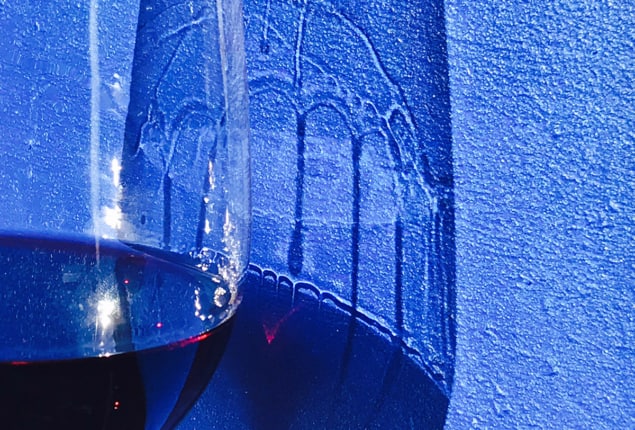Tushna Commissariat ponders the surprising fluid dynamics of wine

See, swirl, sniff, sip and savour – these are the five S’s of wine tasting. You, or the oenophile (wine connoisseur) in your life may be well-versed in swirling that perfect glass of fruity Beaujolais, before deeply inhaling the bouquet, and then finally taking that first sip. While some people consider it a pretentious way to consume a beverage, these steps do have a direct impact on the taste of a glass of wine. Indeed, there’s a surprising amount of science that goes into each of the S’s of wine drinking.
Let’s start with the glass itself. While there’s nothing stopping you from drinking wine from any kind of vessel (including straight from the bottle, should it please you), the shape of a wine glass has a direct impact on the flavours we perceive. A traditional wine glass has four key components: the “foot” or the flat base of the glass; the “stem” or the spindly bit that you hold, which helps keep the wine at the right temperature; the “bowl” or the actual curved receptacle that holds the wine; and finally the “rim” or the edge of the glass.
The shape of the glass determines how the vapours of the ethanol – the alcoholic bit in wine – reaches the nose and mouth. The strength and intensity of a wine’s aroma depend on the size of the bowl relative to the rim – the bigger the bowl, the more aromas will be released; and the more tapered the rim, the easier it is for these scents to reach your nose. Most wine glasses are shaped so that the aromas are centred within the bowl, while the ethanol is pushed out to the rim, not reaching the nose.
Even the taste of the wine, once you sip it, is impacted by the shape of the glass. You’ll find yourself tilting your head either forwards (likely when tasting from a wide-brimmed glass) or backwards (while attempting to navigate your nose past the brim of a narrow flute). The tilt of your head determines the speed and intensity with which the wine enters your mouth, which in turn dictates how many of your tastebuds are impacted at the same time. This accounts for the strong “mouthfeel” of a full-bodied Merlot, for example.
Beyond the physical glass, aficionados are often tempted to swirl their wine, and comment on its “legs” as an indicator of quality. Also dubbed “tears”, “fingers” and even “church windows”, this is the ring of drops that forms near the top of your glass, and it is rooted in physics.
These tears are a consequence of wine being an inhomogeneous mix of water and alcohol (along with some sugars and acids). As you swirl your glass, most of the wine sloshes back down, but a thin film is left behind on the walls of the glass – capillary action making it climb the sides. What’s happening is that the alcohol and the water in the film begin to evaporate quicker than in the bulk of your drink – but the alcohol in the film evaporates faster than the water due to its higher vapour pressure. The alcohol’s swift evaporation and its consequent drop in concentration means that the surface tension of the film increases, pulling up liquid from the bottom of your glass, which has a lower surface tension (as it still has more alcohol).
This flow of liquid due to surface tension gradients is referred to as the “Marangoni effect” in honour of the Italian physicist Carlo Marangoni, who originally studied mass transfer along an interface between two phases due to a gradient in surface tension. But the first person to accurately describe the basic mechanism behind the “tears of wine” phenomenon, in 1855, was physicist James Thomson, the elder brother of Lord Kelvin.
While the Marangoni effect explains the flow of wine up the side of the glass, it was for many years unclear why the flow forms individual drops. But could gravity hold the answer? In 2019 Andrea Bertozzi and colleagues at the University of California, Los Angeles, carried out a theoretical analysis of the non-classical dynamics of wine glasses and wine tears, factoring in gravitational effects that were previously ignored (Phys. Rev. Fluids 5 034002).
Their model found that the film’s thickness plays a key role in how the tears are formed. Indeed, if the film is uniform and thick enough, it flows back down in a sheet. Their experiments and calculations instead showed that the liquid moves up in a bulging wave that leaves behind a thin film. They describe this as an unstable “reverse undercompressive shock wave”, which breaks up to form tears.
This type of Marangoni flow does not just affect wine but has an influence on everything from crystal growth in semiconductors to the radiation of heat in your laptop. In fact, over the last decade, the European Space Agency (ESA), NASA and the Japan Aerospace Exploration Agency have all carried out experiments to study the effect on the International Space Station, in microgravity, with a new ESA experiment due to start next year.
Despite all the physics involved, the tears of wine don’t indicate how good the wine is, but simply its alcohol content. Literally, more alcohol means more tears.



